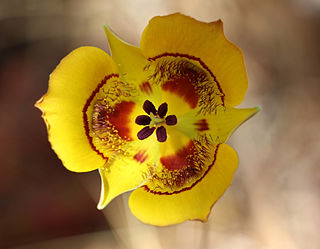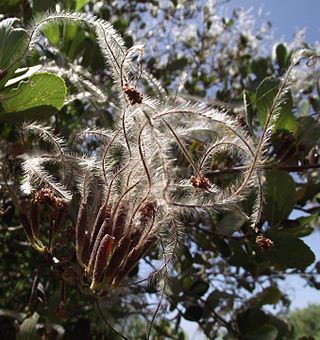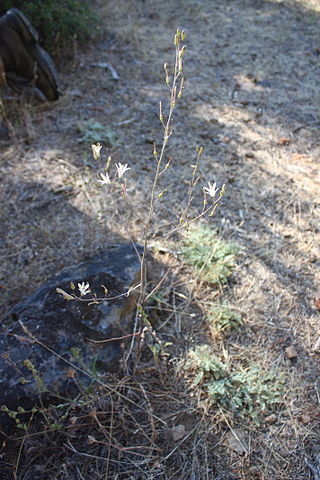
The common names soap plant, soaproot and amole refer to the genus Chlorogalum. They are native to western North America, with some species in Oregon but they are mostly found in California. Common names of the genus and several species derive from their use as soap.

Ribes malvaceum, the chaparral currant, is a member of the Grossulariaceae. It is native to California and northern Baja California, where it occurs from sea level to 1,500 metres (4,900 ft), in chaparral, foothill oak woodland, and closed-cone pine forest habitats.

Eriogonum fasciculatum is a species of wild buckwheat known by the common names California buckwheat and flat-topped buckwheat. Characterized by small, white and pink flower clusters that give off a cottony effect, this species grows variably from a patchy mat to a wide shrub, with the flowers turning a rusty color after blooming. This plant is of great benefit across its various habitats, providing an important food resource for a diversity of insect and mammal species. It also provides numerous ecosystem services for humans, including erosion control, post-fire mitigation, increases in crop yields when planted in hedgerows, and high habitat restoration value.

Salix lasiolepis is a species of willow native to western North America.
Hosackia crassifolia, synonym Lotus crassifolius, is a species of legume native to Washington, California and Oregon. It is known by the common names big deervetch and broad-leafed lotus.

Calochortus clavatus is a species of mariposa lily known by the common name clubhair mariposa lily. It is endemic to California where it is found in forests and on chaparral slopes.

Hooveria purpurea is a species of flowering plant related to the agaves known by the common name purple amole. This species of soap plant is endemic to California, where it grows in the Santa Lucia Range, in the Central Coast region. There are two varieties of this plant, and both are believed to be quite rare. It is a federally listed threatened species.

Eryngium aristulatum, known by the common names California eryngo and Jepson's button celery, is a species of flowering plant in the family Apiaceae.

Sambucus racemosa is a species of elderberry known by the common names red elderberry and red-berried elder.

Cercocarpus betuloides is a shrub or small tree in the rose family. Its common names include mountain mahogany and birch leaf mountain mahogany The common name "mahogany" comes from the hardness and color of the wood, although the genus is not a true mahogany.

Chlorogalum angustifolium is a species of flowering plant, known by the common name narrowleaf soap plant.

Chlorogalum grandiflorum is a species of flowering plant known by the common name Red Hills soap plant. It is endemic to the Sierra Nevada foothills, such as the Red Hills, of California, where it grows in chaparral, woodland, and forest.

Hooveria parviflora is a species of perennial herb known by the common name smallflower soap plant. It is a monocot, native to coastal southern California and Baja California, where it is a member of the coastal sage scrub flora. It resembles a smaller version of Chlorogalum pomeridianum, with wavy leaves and white flowers that open during the day.

Ribes divaricatum is a species in the genus Ribes found in the forests, woodlands, and coastal scrub of western North America from British Columbia to California. The three accepted varieties have various common names which include the word "gooseberry". Other common names include coast black gooseberry, wild gooseberry, Worcesterberry, or spreading-branched gooseberry.

Ribes californicum, with the common name hillside gooseberry, is a North American species of currant. It is endemic to California, where it can be found throughout many of the California Coast, Transverse, and Peninsular Ranges in local habitat types such as chaparral and woodlands.

Ribes inerme is a species of currant known by the common names whitestem gooseberry and white stemmed gooseberry. It is native to western North America from British Columbia to California and westward to the Rocky Mountains. It grows in mountain forests, woodlands, and meadows.

Sidalcea malviflora is a species of flowering plant in the mallow family, known by the common names dwarf checkerbloom, Greek mallow, prairie mallow and dwarf checkermallow.

Berberis dictyota, now reclassified as Berberis aquifolium var. dictyota, with the common names Jepson's oregon grape and shining netvein barberry, is a flowering plant in the Barberry family.

Hooveria is a genus of perennial bulbous plants in the Agavaceae family native to California and northwest Baja California. They are among a number of taxa referred to as amole. They are characterized by diurnal flowering and were formerly placed in the genus Chlorogalum, which consists of vespertine flowering species. They are named in honor of Robert F. Hoover, a field botanist from California who was responsible for founding the botanical garden and herbarium at California State Polytechnic College.



















